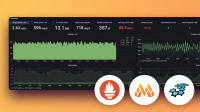Important: This documentation is about an older version. It's relevant only to the release noted, many of the features and functions have been updated or replaced. Please view the current version.
Migrating from Thanos or Prometheus to Grafana Mimir
This document guides an operator through the process of migrating a deployment of Thanos or Prometheus to Grafana Mimir.
Overview
Grafana Mimir stores series in TSDB blocks uploaded in an object storage bucket. These blocks are the same as those used by Prometheus and Thanos. Each project stores blocks in different places and uses slightly different block metadata files.
Configuring remote write to Grafana Mimir
For configuration of remote write to Grafana Mimir, refer to Configuring Prometheus remote write.
Uploading historic blocks to the Grafana Mimir storage bucket
Prometheus stores TSDB blocks in the path specified in the --storage.tsdb.path flag.
To find all blocks directories in the TSDB <STORAGE TSDB PATH>, run the following command:
find <STORAGE TSDB PATH> -name chunks -exec dirname {} \;Grafana Mimir supports multiple tenants and stores blocks with a tenant prefix.
With multi-tenancy disabled, there is a single tenant called anonymous.
Copy each directory output from the previous command to the Grafana Mimir object storage bucket with your tenant prefix.
- For AWS S3, use the
awstool in the following command:
aws s3 cp <DIRECTORY> s3://<TENANT>/<DIRECTORY>- For Google Cloud Storage (GCS), use the
gsutiltool in the following command:
gsutil -m cp -r <DIRECTORY> gs://<TENANT>/<DIRECTORY>Block metadata
Each block has a meta.json metadata file that is used by Grafana Mimir, Prometheus, and Thanos to identify the block contents.
Each project has its own metadata conventions.
In the Grafana Mimir 2.1 (or earlier) release, the ingesters added an external label to the meta.json file to identify the tenant that owns the block.
In the Grafana Mimir 2.2 (or later) release, blocks no longer have a label that identifies the tenant.
Note: Blocks from Prometheus do not have any external labels stored in them; only blocks from Thanos use labels.
Considerations on Thanos specific features
Thanos requires that Prometheus is configured with external labels.
When the Thanos sidecar uploads blocks, it includes the external labels from Prometheus in the meta.json file inside the block.
When you query the block, Thanos injects Prometheus’ external labels in the series returned in the query result.
Thanos also uses labels for the deduplication of replicated data.
If you want to use existing blocks from Thanos by Grafana Mimir, there are some considerations:
Grafana Mimir doesn’t inject external labels into query results. This means that blocks that were originally created by Thanos will not include their external labels in the results when queried by Grafana Mimir. If you need to have external labels in your query results, this is currently not possible to achieve in Grafana Mimir.
Grafana Mimir will not respect deduplication labels configured in Thanos when querying the blocks. For the best query performance please only upload Thanos blocks from single Prometheus replica from each HA pair. If you upload blocks from both replicas, the query results returned by Mimir will include samples from both replicas.
Note: Thanos provides
thanos tools bucket rewritetool for manipulating blocks in the bucket. It may be possible to use this tool to embed external labels into blocks. Please refer tothanos tools bucket rewritedocumentation for more details.
Grafana Mimir does not support Thanos’ downsampling feature.
To guarantee query results correctness please only upload original (raw) Thanos blocks into Mimir’s storage.
If you also upload blocks with downsampled data (ie. blocks with non-zero Resolution field in meta.json file), Grafana Mimir will merge raw samples and downsampled samples together at the query time.
This may cause that incorrect results are returned for the query.
Note: It is possible to run compaction and deduplicate blocks by Thanos first by using
thanos compactcommand with--compact.enable-vertical-compaction --deduplication.func=penalty --deduplication.replica-label=<LABEL>flags. Please refer to Vertical Compaction Use Cases for more details on offline deduplication.



